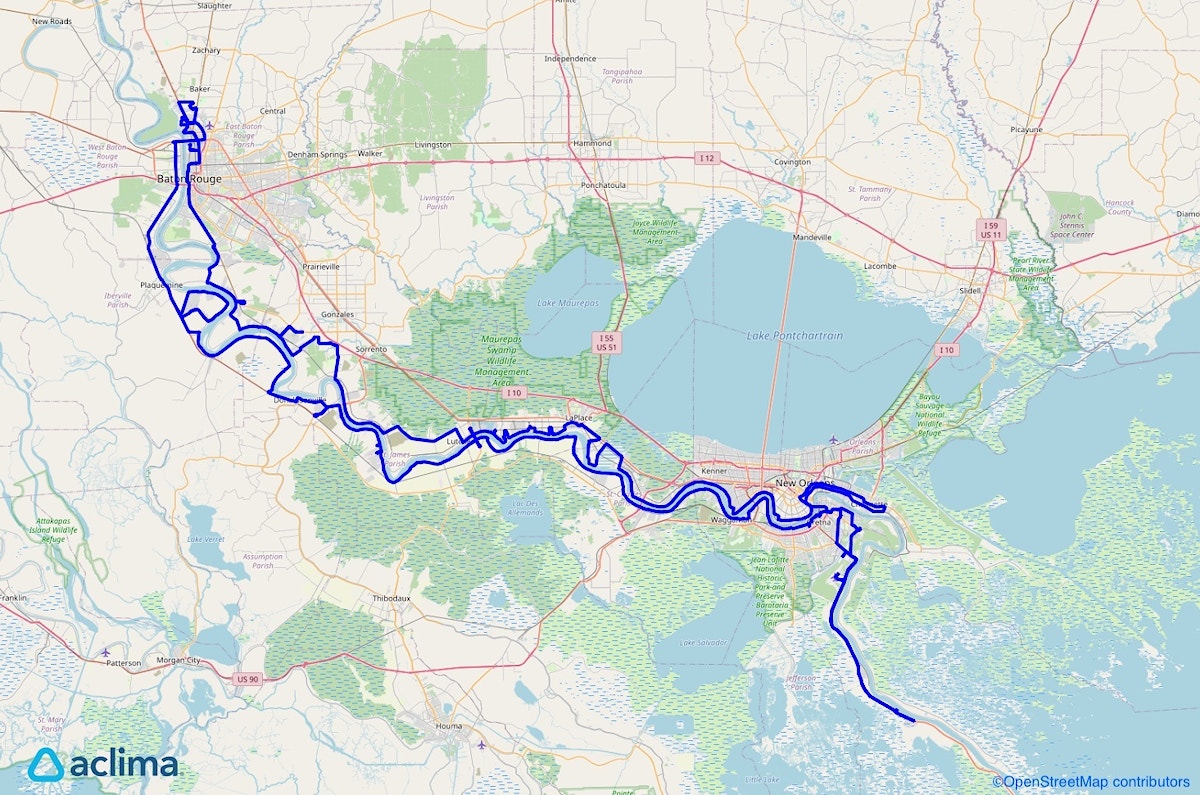LEAN’s decades of work have built a network of residents and community organizations that work collaboratively to resolve issues, with a long history of addressing air quality concerns. Air quality concerns have been the most prevalent and long standing issue residents have sought support from LEAN for over the past 37 years. LEAN has employed many different strategies in working to improve air quality in Louisiana. The development of LEAN's Louisiana Community Air Monitoring Network is the latest effort to address air quality. concerns in Louisiana.
CONCERN
Many residents in Louisiana reside amongst a variety of potentially hazardous pollution sources including transportation infrastructure (marine shipping, rail and road) as well as hundreds of major industrial sources (power generation, petroleum refining, chemical and plastic manufacturing). This is particularly true of communities within the River Parishes along the Mississippi River in south Louisiana where there has been a long history of community concerns over air pollution, fumes, odors and accidents.
Currently, the Louisiana Department of Environment Quality (LDEQ) maintains approximately 40 stationary monitoring sites to measure air quality. These stationary monitors are insufficient to accurately measure air quality across Louisiana's diverse landscape where thousands of residents live intermingled with hundreds of pollution sources.
Residents living in close proximity to a potentially hazardous source must currently depend on data from the closest stationary monitor which may be miles away, may not detect specific pollutants of concern and may not be positioned appropriately depending on seasonal wind directions. This fundamental data gap, along with persistent community concerns led LEAN to develop our latest project. Hyper-local monitoring, across a wide range of pollutants is a necessary step to develop a clear picture of actual air quality within the communities we all reside. Without this data, we can not make informed decisions to protect public health and improve quality of life in Louisiana.
PROJECT SUMMARY
In 2023, LEAN received support from the United States Environmental Protection Agency (EPA) through EPA-OAR-OAQPS-22-01: Enhanced Air Quality Monitoring for Communities, to develop the Louisiana Community Air Monitoring Network. This project aims to expand air quality data and air quality literacy, specifically in the parishes bordering the Mississippi River, between Baton Rouge and New Orleans, Louisiana's two largest cities.
LEAN is working to achieve this effort by collecting extensive, high resolution air quality data across the region while coordinating with diverse stakeholders to review this data and identify collaborative opportunities for air quality improvements.
On December 11, 2023, a fleet of mobile monitoring vehicles operated by technology company Aclima, began collecting air quality data around the clock. The monitoring route extends approximately 300 linear miles along the East and West bank of the Mississippi River in south Louisiana. The monitoring route passes through many communities including: Alsen, Baton Rouge, Port Allen, St. Gabriel, Plaquemine, Geismar, Donaldsonville, Convent, St James, Lutcher, Reserve, Norco, Hahnville,St Rose, River Ridge, Waggaman,Jefferson, Westwego, New Orleans, Gretna, St Bernard, Belle Chasse, and Oakville, among others.


Pollutants Measured
Pollutants being measured include: carbon dioxide (CO2), carbon monoxide (CO), fine particulate matter (PM 2.5), nitrogen dioxide (NO2), ozone (O3), black carbon, tVOC and BTEX(benzene, toluene, ethylbenzene, and xylene).
Aclima's hyper-local monitoring will continue through mid March 2024. Following this data collection, this unprecedented, region wide dataset will be analyzed to identify areas of concern and locations for continued monitoring.
Aclima’s technical expertise, LEAN’s Technical Director Wilma Subra and Technical Advisor Dr. Slawo Lomnicki are working in cooperation with our community network to assess and analyze the data produced by this project on an on-going basis. LEAN is committed to full transparency and open communication and is providing information produced by this project to all interested parties with the goal of addressing air quality concerns, protecting public health and our environment. All data and resources produced by this project can be found here.
For additional information or if you would like to schedule a data discussion specific to your community, please contact us.
Community Air Maps
-
MAP- Geismar Community Air Data
Explore this map to view air quality data collected by Aclima's mobile monitoring fleet in the Geismar area.
-
MAP- St Gabriel Community Air Data
Explore this map to view air quality data collected by Aclima's mobile monitoring fleet in St Gabriel area.
-
MAP-Alsen Community Air Data
Explore this map to view air quality data collected by Aclima's mobile monitoring fleet in the Alsen area.
-
MAP-North Baton Rouge Community Air Data
Explore this map to view air quality data collected by Aclima's mobile monitoring fleet in North Baton Rouge.
-
MAP-Reserve Community Air Data
Explore this map to view air quality data collected by Aclima's mobile monitoring fleet in the Reserve area.
-
MAP-River Ridge Community Air Data
Explore this map to view air quality data collected by Aclima's mobile monitoring fleet in the River Ridge area.
-
MAP-St James Community Air Data
Explore this map to view air quality data collected by Aclima's mobile monitoring fleet in the St James area.
